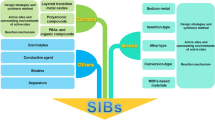Abstract
The hydrogen ionization process is studied experimentally on an industrial sintered nickel oxide electrode in models of sealed nickel-metal hydride batteries. It is shown that the hydrogen ionization rates that are reached during overcharge by high current densities in conditions of forced gas delivery into the electrode pores (up to 40 mA cm−2) exceed the self-discharge rate of a nickel-hydrogen battery by two orders of magnitude. Up to 70% of hydrogen delivered into the compact assembly block undergoes ionization during forced charge of models of sealed nickel-metal hydride batteries with a closed hydrogen cycle. Two independent methods (potentiostatic and manometric) are used to determine the relationship between rates of hydrogen ionization with the degree of the electrode filling with gas and perform estimation of the process intensity at a unit reaction surface. It is established that, in conditions of forced gas delivery, practically all the hydrogen oxidation current is generated at the surface of the nickel oxide electrode beneath thin films of an electrolyte solution at the rate of 4–5 mA cm−2. It is shown that the hydrogen oxidation rate on a nickel oxide electrode filled in part by gas is independent of the electrode potential, probably because of a tangible contribution made by diffusion limitations to the overall hampering of the process.
Similar content being viewed by others
References
Belov, O.I., Krupin, V.P., and Tyurin, I.A., Sb. Tr. Khim. Ist. Toka, 2004, p. 190.
Shokhor, A.B. and Gromova, N.G., Sb. Tr. Khim. Ist. Toka, 2004, p. 97.
Borisov, B.A., Voshchikova, T.D., Ten’kovtsev, V.V., and Gililo, G.S., Sb. Tr. Khim. Ist. Toka, 2004, p. 109.
Do, Y.J., Back, H.L., and Sun, W.K., J. Power Sources, 2002, vol. 109, p. 1.
Ikeya, T., Sawada, N., Murakami, J.I., Kobayashi, K., Hattori, M., Murotani, N., Ujiie, S., Kajiyama, K., Nasu, H., Narisoko, H., Tomaki, Y., Adachi, K., Mita, Y., and Ishihara, K., J. Power Sources, 2002, vol. 105, p. 6.
Yang, X.G. and Liaw, B.Y., J. Power Sources, 2001, vol. 101, p. 158.
Zhu, X., Yang, H., and Ai, X., Electrochim. Acta, 2003, vol. 48, p. 4033.
Kim, D.-M., Lee, H., Cho, K., and Lee, J.-Y., J. Alloys Compd., 1999, vol. 282, p. 261.
Vassal, N., Salmon, E., and Fauvarque, J.F., J. Electrochem. Soc., 1999, vol. 146, p. 20.
Yang, X.G. and Liaw, B.Y., J. Electrochem. Soc., 2001, vol. 148, p. A1023.
Yan, D.Y., Cheng, Q., and Cui, T., J. Alloys Compd., 1999, vol. 293–295, p. 809.
Mao, L., Shan, Zh., Yin, Sh., Liu, B., and Wu, F., J. Alloys Compd., 1999, vol. 293–295, p. 825.
Lee, S.M., Park, J.Q., Han, S.Ch., Lee, P.S., and Lee, J.Y., J. Electrochem. Soc., 2002, vol. 149, p. A1278.
Ikoma, M., Yuasa, Sh.I., Yuasa, K., Kaida, S., Matsumoto, I., and Iwakura, Ch., J. Alloys Compd., 1998, vol. 267, p. 252.
Shokhor, A.B., Gromova, N.G., and Belyaevskaya, N.A., Sb. Tr. Khim. Ist. Toka, 2004, p. 104.
Knosp, B., Vallet, L., and Blanchard, Ph., J. Alloys Compd., 1999, vol. 293–295, p. 770.
Khomskaya, E.A. and Gorbacheva, N.F., Elektrokhimiya, 1985, vol. 21, p. 122.
Rudik, I.V., Nikolaev, A.V., and Avrutskaya, I.A., Elektrokhimiya, 1987, vol. 23, p. 1235.
Petrii, O.A., Smirnova, N.V., and Aminov, A.Yu., Elektrokhimiya, 1998, vol. 34, p. 1124.
Rethinam, A.J. and Kennedy, C.J., J. Appl. Electrochem., 2004, vol. 34, p. 371.
Tsenter, B.I. and Kloss, A.I., Elektrokhimiya, 1976, vol. 12, p. 1187.
Shokhor, A.B., Tsenter, B.I., Kloss, A.I., and Sergeev, V.M., Sb. Tr. Khim. Ist. Toka, 1974, issue 9, p. 107.
Khomskaya, E.A., Burdanova, N.F., and Gorbacheva, N.F., Upravlenie gazozhidkostnym potokom pri zaryade akkumulyatorov (Governing Gas and Liquid Flows when Charging Batteries), Saratov: Saratov. Univ., 1998.
Khomskaya, E.A., Kolosov, A.S., Terent’ev, N.K., and Burdanova, N.F., Elektrokhimiya, 1976, vol. 12, p. 1241.
Mokhnatkin, V.M., Khomskaya, E.A., Kudryashova, G.M., and Chirkov, Yu.G., Elektrokhimiya, 1983, vol. 19, p. 200.
Author information
Authors and Affiliations
Corresponding author
Additional information
Original Russian Text © A.V. Semykin, I.A. Kazarinov, E.A. Khomskaya, 2006, published in Elektrokhimiya, 2006, Vol. 42, No. 6, pp. 719–724.
Rights and permissions
About this article
Cite this article
Semykin, A.V., Kazarinov, I.A. & Khomskaya, E.A. Studying the process of ionization of hydrogen in conditions of its forced delivery to a porous nickel oxide electrode. Russ J Electrochem 42, 643–648 (2006). https://doi.org/10.1134/S1023193506060085
Received:
Issue Date:
DOI: https://doi.org/10.1134/S1023193506060085




